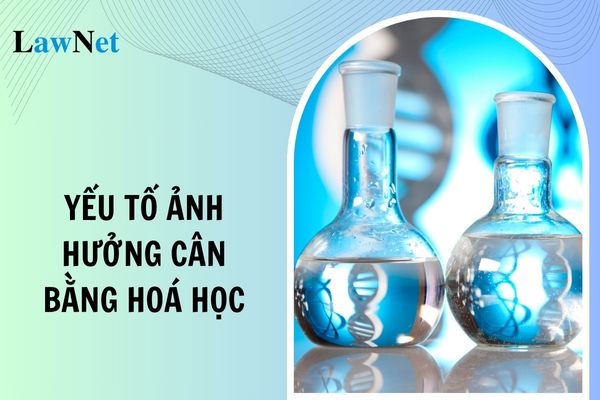What are the factors affecting chemical equilibrium according to the Chemistry curriculum in Vietnam?
What are the factors affecting chemical equilibrium according to the Chemistry curriculum in Vietnam?
Chemical equilibrium and the factors affecting chemical equilibrium are topics covered in Grade 11. Chemical equilibrium can be understood as the state of a reversible reaction when the rate of the forward reaction equals the rate of the reverse reaction.
There are three factors that affect chemical equilibrium: temperature, concentration, and pressure. To be specific:
- Effect of temperature on chemical equilibrium: When the temperature increases, the equilibrium shifts in the direction that reduces the temperature, which means the endothermic reaction direction, to counteract the effect of the temperature increase, and vice versa.
- Effect of concentration: When the concentration of a substance in the reaction increases, the chemical equilibrium becomes disrupted and shifts in the direction that reduces the concentration of that substance, and vice versa.
- Effect of pressure: When the overall pressure of the system increases, the equilibrium shifts in the direction that reduces the pressure, which means the direction that reduces the number of gas moles, and vice versa. Pressure only affects the equilibrium when gases are involved.
Note: The content on the factors affecting chemical equilibrium is for reference purposes only!

What are the factors affecting chemical equilibrium according to the Chemistry curriculum in Vietnam? (Image from the Internet)
What content needs to be achieved in the chapter on chemical equilibrium in Grade 11 Chemistry in Vietnam?
Based on the General Education Program issued with Circular 32/2018/TT-BGDDT, the content to be achieved in the chemical equilibrium chapter of Grade 11 Chemistry is as follows:
- Concept of chemical equilibrium:
+ Explain the concept of reversible reactions and the state of equilibrium of a reversible reaction.+ Write the equilibrium constant expression (KC) of a reversible reaction.
+ Conduct experiments to study the effect of temperature on equilibrium shifts:
(1) Reaction: 2NO2 ⇌ N2O4
(2) Hydrolysis of sodium acetate.
+ Apply Le Chatelier's principle to explain the effect of temperature, concentration, and pressure on chemical equilibrium.
- Equilibrium in aqueous solutions:
+ Define ionization, electrolytes, and non-electrolytes.
+ Explain the Brønsted-Lowry theory of acids and bases.
+ Define and explain the practical significance of pH (relating pH values in the body to human health, pH of soil and water to the development of plants and animals, etc.).
+ Write the pH calculation expression (pH = -lg[H+] or [H+] = 10^-pH) and know how to use indicators to determine pH (acidic, basic, neutral environments) with common indicators like pH paper, litmus paper, phenolphthalein, etc.
+ Describe the principle of determining the concentration of strong acids and bases by titration.
+ Conduct acid-base titration experiments: Titrate a strong base (sodium hydroxide) with a strong acid (hydrochloric acid).
+ Explain the practical significance of equilibrium in aqueous solutions of Al3+, Fe3+ ions.
What does the Chemistry teaching equipment set in Vietnam include?
Based on the General Education Program issued with Circular 32/2018/TT-BGDDT, the chemistry teaching equipment set includes:
- Periodic table of chemical elements; solubility charts of salts and hydroxides; electron configuration chart of metals/first-row transition metal ions; color chart of some transition metal compounds.
- Illustrative images of the geometry of some complex compounds, of Cu2+ salts in aqueous solutions; structures of some biological complexes like heme B, chlorophyll, vitamin B12 and those used in medicine such as cisplatin, carboplatin, etc.; 3R symbols; recycling of aluminum; the silicate industry; the production of cement, ceramics, and pottery. Schematics of distillation, petrochemical processing, and petroleum applications. Images of the applications of alkanes, alkenes, alkadienes, arenes in practice; applications of halogen derivatives; alcohols and phenols in practice; the role of amino acids, the role of glucose, and starch in life.
- Models or assembly kits of hollow or solid structures of some alkanes; benzene, halogen derivatives, ethylic alcohol, and phenol; amines, amino acids, peptides, and proteins.
- Electronic Learning Resources:
+ Software for calculations; virtual experiments software.
+ Videos of hazardous, dangerous explosive experiments, complex experiments, etc. such as experiments with chlorine, bromine, etc., interactions of alkali metals, alkaline earth metals with water, etc.
Equipment for hands-on practice
- Analytical and measurement instruments: electrolysis apparatus for copper (II) sulfate solution and sodium chloride solution; electrical conductivity tester; handheld pH meters; etc.
- Sufficient equipment, tools, and chemicals according to the minimum teaching equipment list prescribed by the Ministry of Education and Training.


- Directive on National Resistance when Established? What Grade Level is 9th Grade?
- Vietnam: What is the overview of industrial revolutions over periods in the 10th-grade History curriculum? What knowledge about industrial revolutions do 10th-grade students learn?
- What is the Plan for organizing professional training for English teachers in Ho Chi Minh City about?
- Vietnam: What are the sample outlines of a social argumentative essay on kindness for 9th-grade students? What are the kindness qualities required for 9th-grade students?
- Vietnam: What are the sample argumentative essays on respecting people's differences for 11th-grade students? What are the conditions for 11th-grade students to be eligible for grade advancement?
- Are students pursuing dance in Vietnam eligible for tuition reduction?
- What are the standards for facilities of a Center for Continuing Education and Vocational Education in Vietnam?
- What are the conditions for a foreign educational institution to establish a representative office in Vietnam?
- What is the term of office of the principal of an intermediate school in Vietnam?
- What are the eligibility criteria for applying to an upper-secondary boarding ethnic school in Vietnam?

